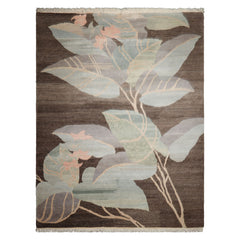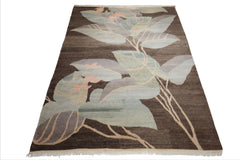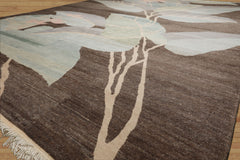



















Brown 8'10''x11'6" Tibetan Art Deco Plush pile Hand Knotted Wool Oriental Area Rug
- $1,199.99
$3,599.97- $1,199.99
- Unit price
- per
- Exact Size: 8'10"x11'6"
- Weave: Hand Knotted Rug
- Yarn: Wool
- Color: Brown, aqua, Gray, Rose, Ivory, Blue, Multi
- Origin: Nepal
- Pile Height: 0.75 inch
- Condition: new
- Condition Description: New With Tags
- Rug#: AOR19680
Tibetan rugs have a rich cultural history rooted in centuries of use for both decorative and practical purposes, often featuring symbolic and natural motifs like snow lions, florals, and geometric patterns. This traditional art form experienced a major turning point after 1959, when the Chinese invasion of Tibet led many Tibetans to settle in Nepal and India. As the Tibetan diaspora grew, so did the commercial revival of rug weaving—especially in the 1970s when global demand surged. Nepalese artisans played a crucial role in keeping the tradition alive and evolving. Tibetan rugs are uniquely crafted using a slit-loop method known as the Tibetan knot, which creates a richly textured and plush surface. Today’s Tibetan, Nepalese, and Indo-Tibetan rugs often blend ancient symbolism with contemporary design, offering everything from traditional motifs to modern, abstract interpretations—all while preserving the essence of Tibetan craftsmanship.
Related Products
- $1,199.99
$3,599.97- $1,199.99
- Unit price
- per
- $1,199.99
$3,599.97- $1,199.99
- Unit price
- per
- $1,199.99
$3,599.97- $1,199.99
- Unit price
- per
- $1,199.99
$3,599.97- $1,199.99
- Unit price
- per
- $1,199.99
$3,599.97- $1,199.99
- Unit price
- per
- $1,199.99
$3,599.97- $1,199.99
- Unit price
- per
- $1,199.99
$3,599.97- $1,199.99
- Unit price
- per
- $1,199.99
$3,599.97- $1,199.99
- Unit price
- per
- $1,199.99
$3,599.97- $1,199.99
- Unit price
- per
- $1,199.99
$3,599.97- $1,199.99
- Unit price
- per
- Choosing a selection results in a full page refresh.

